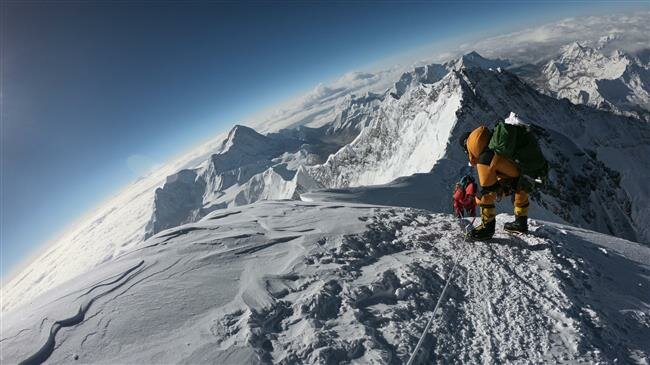Two more climbers killed amid traffic jam on Everest
The deaths of an Irish and a British climber on Mount Everest took the toll from a deadly season on the world’s highest peak to 10, expedition organizers said Saturday.
British climber Robin Fisher, 44, reached the summit Saturday morning but collapsed when he had got just 150 meters back down the slope.
“Our guides tried to help but he died soon after,” Murari Sharma of Everest Parivar Expedition told AFP.
On the northern Tibet side of the mountain, a 56-year-old Irish man died Friday morning, his expedition organizers confirmed in a statement on their Facebook page.
The climber decided to return without reaching the summit but died in his tent at the North Col pass at 7,000 meters (22,965 feet).
With two or three more days of climbing to come before hostile weather closes the summit again, the season is on target to be one of the most deadly of recent years.
Four climbers from India and one each from the United States, Austria and Nepal have died on Everest during the short climbing season. Another Irish mountaineer is presumed dead after he slipped and fell close to the summit.
A traffic jam of climbers in the Everest “death zone” has been blamed for at least four of the deaths.
With the short window of suitable weather due to close soon, scores of climbers wanting to achieve the ultimate mountaineering accolade created bottlenecks close to the summit.
Teams had to line up for hours in freezing temperature to reach the top — risking frostbite and deadly altitude sickness.

Little has changed since a photo of a huge traffic jam below the summit in 2012 prompted calls for better crowd management, and even a cap on the number of permits.
That year, 10 people died on the mountain — one of the worst outside of 2014 and 2015 when an avalanche and an earthquake caused disasters that killed 16 and 18 people respectively.
Seven-time Everest summiteer Lam Babu Sherpa, who was with 13 foreign climbers in the jam on Wednesday, said that such traffic can be fatal, especially if teams do not carry extra oxygen.
“There were over 200 people on that line, and you can’t overtake. It was very difficult, we saw teams wait for two to three hours,” Sherpa said.
“Many climbers were exhausted and getting slow, risking themselves and others. There is high chance of frostbite and even death.”
Nepal issued a record 381 permits for mainly foreign climbers, costing $11,000 each, for the spring climbing season from late April to the end of May.
Each climber with a permit is assisted by at least one guide, adding to the summit logjam.
An estimated 600 people had reached the summit via the Nepal side by Friday, a government official said, based on information from expedition organizers.
At least 140 others have been granted permits to scale Everest from the northern flank in Tibet, according to operators. This could take the total past last year’s record of 807 people reaching the summit.
It is peak season for many Himalayan mountains and outside of Everest nine climbers have died on other 8,000-meter-plus peaks, while one is missing.
(Source: AFP)





